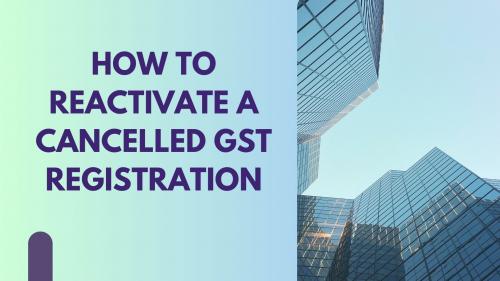How to Reactivate a Cancelled GST Registration

Reactivating a cancelled
Goods and Services Tax (GST) registration can be a crucial task for businesses
that have previously cancelled their registration but now wish to resume their
operations under the GST framework. The reactivation process involves adhering
to specific guidelines and procedures established by the tax authorities. This
paragraph will provide an overview of the steps involved in reactivating a
cancelled GST registration.
To reactivate a cancelled
GST registration, businesses need to follow a set of systematic procedures and
ensure compliance with regulatory requirements. The process typically
involves the following steps:
Assess the eligibility:
Before proceeding with the reactivation, it is essential to evaluate the
eligibility criteria for reinstating a cancelled GST registration. This
includes confirming that the business meets the necessary turnover threshold
and has the required documents and records.
Application submission: The
next step involves submitting an application to the relevant tax authority for
reactivating the GST registration. This application can usually be done through
an online portal or by visiting the designated office in person. The
application form must be duly filled out with accurate information and
accompanied by the necessary supporting documents.
Document submission: Along
with the application form, specific documents need to be submitted to support
the reactivation request. These documents may include the business's
incorporation certificate, address proof, PAN card details, bank statements,
and any other relevant documents requested by the tax authorities.
Payment of dues, if any: If there are any outstanding tax dues or penalties from the previous registration, it is essential to clear them before initiating the reactivation process. This involves paying the pending dues along with any interest or penalties that may have accrued during the period of cancellation.
Verification process: Once
the application and supporting documents are submitted, the tax authority will
initiate a verification process. This may involve scrutinizing the submitted
information, conducting site visits, and verifying the authenticity of the
documents provided. It is crucial to cooperate fully with the tax authorities during
this process and provide any additional information or clarifications if
required.
Approval and reactivation:
After successful verification and compliance with the necessary requirements,
the tax authority will issue approval for reactivating the cancelled GST
registration. Once the approval is granted, the business can resume its operations
under the GST framework and start collecting and remitting GST as per the
applicable regulations.
Compliance with ongoing
obligations: Reactivating the GST registration is not the end of the process.
The business must continue to fulfil its ongoing obligations, such as filing
regular GST returns, maintaining proper records, and adhering to the GST
compliance requirements. It is crucial to stay updated with any changes in the
GST laws and regulations and ensure timely compliance.
In conclusion, reactivating
a cancelled GST registration involves a systematic approach that includes
assessing eligibility, submitting an application with the required documents,
clearing any outstanding dues, undergoing a verification process, and complying
with ongoing obligations. It is essential to closely follow the guidelines and
procedures provided by the tax authorities to ensure a smooth reactivation
process and avoid any potential penalties or legal complications. Seeking
professional advice from tax experts or consultants can be beneficial to
navigate the complexities associated with reactivating a cancelled GST
registration.
Post Your Ad Here
Comments